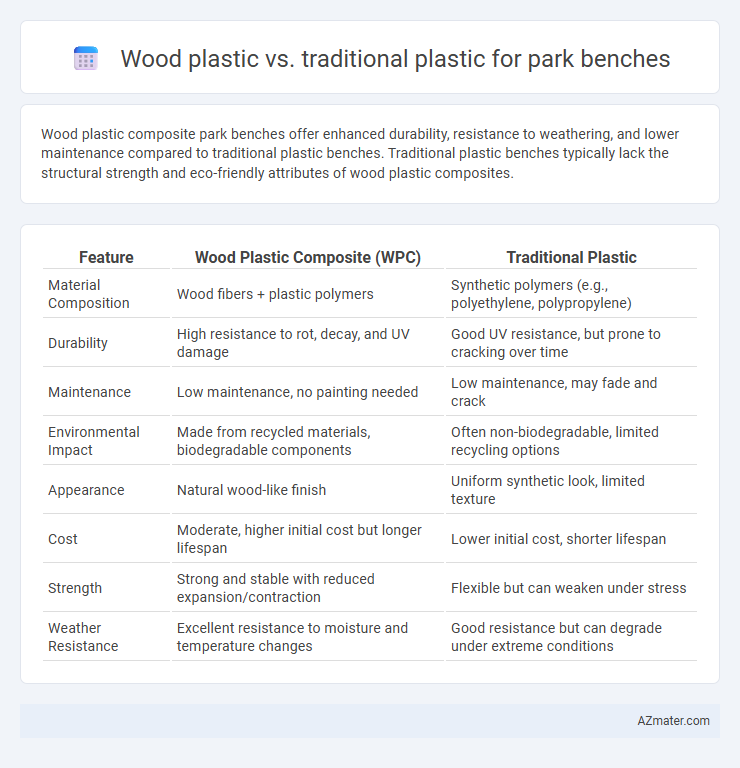Wood plastic composite park benches offer enhanced durability, resistance to weathering, and lower maintenance compared to traditional plastic benches. Traditional plastic benches typically lack the structural strength and eco-friendly attributes of wood plastic composites.
Table of Comparison
| Feature | Wood Plastic Composite (WPC) | Traditional Plastic |
|---|---|---|
| Material Composition | Wood fibers + plastic polymers | Synthetic polymers (e.g., polyethylene, polypropylene) |
| Durability | High resistance to rot, decay, and UV damage | Good UV resistance, but prone to cracking over time |
| Maintenance | Low maintenance, no painting needed | Low maintenance, may fade and crack |
| Environmental Impact | Made from recycled materials, biodegradable components | Often non-biodegradable, limited recycling options |
| Appearance | Natural wood-like finish | Uniform synthetic look, limited texture |
| Cost | Moderate, higher initial cost but longer lifespan | Lower initial cost, shorter lifespan |
| Strength | Strong and stable with reduced expansion/contraction | Flexible but can weaken under stress |
| Weather Resistance | Excellent resistance to moisture and temperature changes | Good resistance but can degrade under extreme conditions |
Introduction to Park Bench Materials
Wood plastic composite (WPC) offers enhanced durability and resistance to weather compared to traditional plastic, making it an increasingly popular choice for park bench materials. Traditional plastic benches often suffer from UV degradation and cracking over time, whereas WPC combines wood fibers with plastic to provide a natural look and improved structural integrity. This blend results in benches that require less maintenance and have longer lifespans, making WPC a cost-effective and sustainable solution for outdoor furniture.
Overview of Wood Plastic Composite
Wood plastic composite (WPC) combines wood fibers and plastic polymers, creating a durable material ideal for park benches due to enhanced weather resistance and reduced maintenance compared to traditional plastic. WPC offers superior aesthetic appeal with natural wood textures alongside improved strength and resistance to rot, moisture, and insect damage. This composite material supports sustainability by utilizing recycled plastics and wood waste, making it an eco-friendly alternative to conventional plastic benches.
Traditional Plastic Bench Materials Explained
Traditional plastic park benches are commonly made from high-density polyethylene (HDPE), polypropylene, and polyvinyl chloride (PVC), offering durability and weather resistance. These materials provide lightweight, low-maintenance solutions but can suffer from UV degradation and environmental concerns due to non-biodegradability. Despite these drawbacks, traditional plastics remain popular for park benches owing to cost-effectiveness and ease of molding into various designs.
Durability: Wood Plastic vs Traditional Plastic
Wood plastic composites (WPC) exhibit superior durability compared to traditional plastic in park benches, resisting UV rays, moisture, and temperature fluctuations without cracking or warping. Traditional plastic benches often degrade under prolonged sun exposure and extreme weather, leading to brittleness and color fading. WPC's enhanced resistance to rot, insects, and wear extends the lifespan of park benches, making it a more reliable long-term investment.
Environmental Impact and Sustainability
Wood-plastic composite (WPC) park benches offer enhanced sustainability due to their use of recycled wood fibers and plastic waste, reducing landfill contributions and conserving natural resources. Traditional plastic benches rely heavily on virgin petroleum-based materials, contributing significantly to carbon emissions and long-term environmental pollution. WPC benches provide superior biodegradability and lower carbon footprints, making them a more eco-friendly choice for public outdoor furniture.
Maintenance Requirements
Wood plastic composite (WPC) park benches demand significantly less maintenance compared to traditional plastic benches, as they resist fading, cracking, and splintering over time. Unlike conventional plastic, WPC materials often require only occasional cleaning and do not need repainting or sealing to maintain their appearance and durability. This makes wood plastic benches a cost-effective and long-lasting solution for outdoor public seating.
Cost Comparison
Wood plastic composites (WPC) for park benches typically have a higher upfront cost than traditional plastic, ranging from $150 to $300 per bench compared to $100 to $200 for traditional plastic options. However, WPC offers longer durability with lifespan extending 15-25 years versus 5-10 years for traditional plastic, reducing replacement frequency and long-term expenses. Maintenance costs for WPC are lower due to resistance to rot, UV damage, and insect infestations, making it more cost-effective over the bench's lifecycle.
Aesthetic Appeal and Design Flexibility
Wood plastic composites (WPC) offer enhanced aesthetic appeal for park benches by mimicking the natural texture and grain of wood, providing a warm and inviting look that traditional plastics often lack. The design flexibility of WPC allows for intricate shapes, customizable colors, and finishes that can better complement outdoor environments, unlike traditional plastics which may have limited stylistic options and often appear artificial. Furthermore, WPC materials resist fading and weathering, maintaining their visual appeal over time, making them a superior choice for durable and attractive park benches.
Weather Resistance and Longevity
Wood plastic composites (WPC) demonstrate superior weather resistance compared to traditional plastic in park benches, as they withstand UV rays, moisture, and temperature fluctuations without cracking or fading. WPC offers enhanced longevity due to its resistance to rot, insects, and warping, extending the lifespan of outdoor furniture beyond that of conventional plastic. This durability makes wood plastic the preferred material for park benches exposed to varying and harsh weather conditions.
Which Material Is Best for Your Park Bench?
Wood plastic composites (WPC) offer superior durability and weather resistance compared to traditional plastic, making them ideal for outdoor park benches exposed to varying climates. Unlike conventional plastic, WPC incorporates natural fibers, enhancing strength and reducing environmental impact while maintaining low maintenance requirements. For park benches prioritizing longevity, sustainability, and aesthetic appeal, wood plastic composites provide a more balanced solution than traditional plastic options.

Infographic: Wood plastic vs Traditional plastic for Park bench
 azmater.com
azmater.com